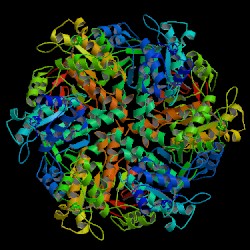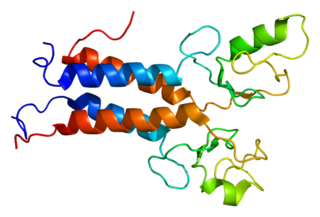Fanconi anemia group J protein is a protein that in humans is encoded by the BRCA1-interacting protein 1 (BRIP1) gene. [5] [6] [7]
Fanconi anemia group J protein is a protein that in humans is encoded by the BRCA1-interacting protein 1 (BRIP1) gene. [5] [6] [7]
The protein encoded by this gene is a member of the RecQ DEAH helicase family and interacts with the BRCT repeats of breast cancer, type 1 (BRCA1). The bound complex is important in the normal double-strand break repair function of breast cancer, type 1 (BRCA1). This gene may be a target of germline cancer-inducing mutations. [7]
This protein also appears to be important in ovarian cancer where it seems to act as a tumor suppressor. [8] Mutations in BRIP1 are associated with a 10-15% risk of ovarian cancer. [9]
BRIP1 appears to have an important role in neuronal cells by suppressing oxidative stress, excitotoxicity induced DNA damage, and in protecting the integrity of mitochondria. [10] A deficiency of BRIP1 causes increased DNA damage, mitochondrial abnormalities and neuronal cell death.
BRIP1 protein is a DNA helicase that is employed in homologous recombinational repair, and in the response of the cell to DNA replication stress. [11] In part, BRIP1 carries out its function through interaction with other key DNA repair proteins, specifically MLH1, BRCA1 and BLM. [11] This group of proteins helps to ensuring genome stability, and in particular repairs DNA double-strand breaks during prophase 1 of meiosis.
BRIP1 has been shown to interact with BRCA1. [12] [13] [14] [15] [16] [17]

Breast cancer type 1 susceptibility protein is a protein that in humans is encoded by the BRCA1 gene. Orthologs are common in other vertebrate species, whereas invertebrate genomes may encode a more distantly related gene. BRCA1 is a human tumor suppressor gene and is responsible for repairing DNA.

ATM serine/threonine kinase or Ataxia-telangiectasia mutated, symbol ATM, is a serine/threonine protein kinase that is recruited and activated by DNA double-strand breaks, oxidative stress, topoisomerase cleavage complexes, splicing intermediates, R-loops and in some cases by single-strand DNA breaks. It phosphorylates several key proteins that initiate activation of the DNA damage checkpoint, leading to cell cycle arrest, DNA repair or apoptosis. Several of these targets, including p53, CHK2, BRCA1, NBS1 and H2AX are tumor suppressors.

DNA repair protein RAD51 homolog 1 is a protein encoded by the gene RAD51. The enzyme encoded by this gene is a member of the RAD51 protein family which assists in repair of DNA double strand breaks. RAD51 family members are homologous to the bacterial RecA, Archaeal RadA and yeast Rad51. The protein is highly conserved in most eukaryotes, from yeast to humans.

CHEK2 is a tumor suppressor gene that encodes the protein CHK2, a serine-threonine kinase. CHK2 is involved in DNA repair, cell cycle arrest or apoptosis in response to DNA damage. Mutations to the CHEK2 gene have been linked to a wide range of cancers.

Double-strand break repair protein MRE11 is an enzyme that in humans is encoded by the MRE11 gene. The gene has been designated MRE11A to distinguish it from the pseudogene MRE11B that is nowadays named MRE11P1.

BRCA1-associated RING domain protein 1 is a protein that in humans is encoded by the BARD1 gene. The human BARD1 protein is 777 amino acids long and contains a RING finger domain, four ankyrin repeats, and two tandem BRCT domains.

Tumor suppressor p53-binding protein 1 also known as p53-binding protein 1 or 53BP1 is a protein that in humans is encoded by the TP53BP1 gene.

DNA topoisomerase 2-binding protein 1 (TOPBP1) is a scaffold protein that in humans is encoded by the TOPBP1 gene.

Mediator of DNA damage checkpoint protein 1 is a 2080 amino acid long protein that in humans is encoded by the MDC1 gene located on the short arm (p) of chromosome 6. MDC1 protein is a regulator of the Intra-S phase and the G2/M cell cycle checkpoints and recruits repair proteins to the site of DNA damage. It is involved in determining cell survival fate in association with tumor suppressor protein p53. This protein also goes by the name Nuclear Factor with BRCT Domain 1 (NFBD1).

RAD51 homolog C , also known as RAD51C, is a protein which in humans is encoded by the RAD51C gene.

Kinesin-like protein KIF1B is a protein that in humans is encoded by the KIF1B gene.

Retinoblastoma-binding protein 8 is a protein that in humans is encoded by the RBBP8 gene.

Zinc finger protein 350 is a protein that in humans is encoded by the ZNF350 gene.

Partner and localizer of BRCA2, also known as PALB2 or FANCN, is a protein which in humans is encoded by the PALB2 gene.

Transcriptional repressor CTCFL also known as BORIS is a protein that in humans is encoded by the CTCFL gene.
TOX high mobility group box family member 3, also known as TOX3, is a human gene.

PARP inhibitors are a group of pharmacological inhibitors of the enzyme poly ADP ribose polymerase (PARP).

BRCA1 C Terminus (BRCT) domain is a family of evolutionarily related proteins. It is named after the C-terminal domain of BRCA1, a DNA-repair protein that serves as a marker of breast cancer susceptibility.

GTP-binding protein Di-Ras3 (DIRAS3) also known as aplysia ras homology member I (ARHI) is a protein that in humans is encoded by the DIRAS3 gene.

Breast and ovarian cancer does not necessarily imply that both cancers occur at the same time, but rather that getting one cancer would lead to the development of the other within a few years. Women with a history of breast cancer have a higher chance of developing ovarian cancer, vice versa.